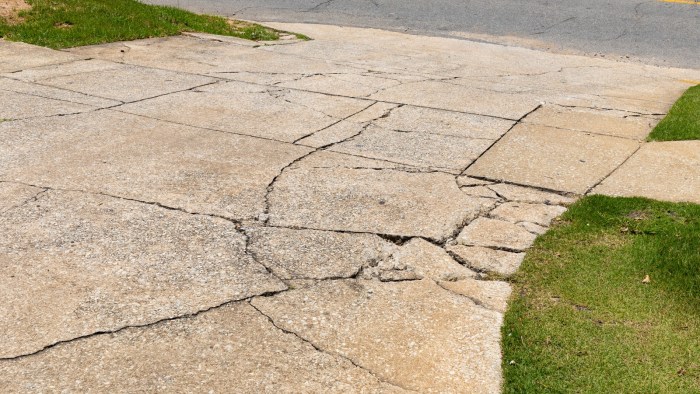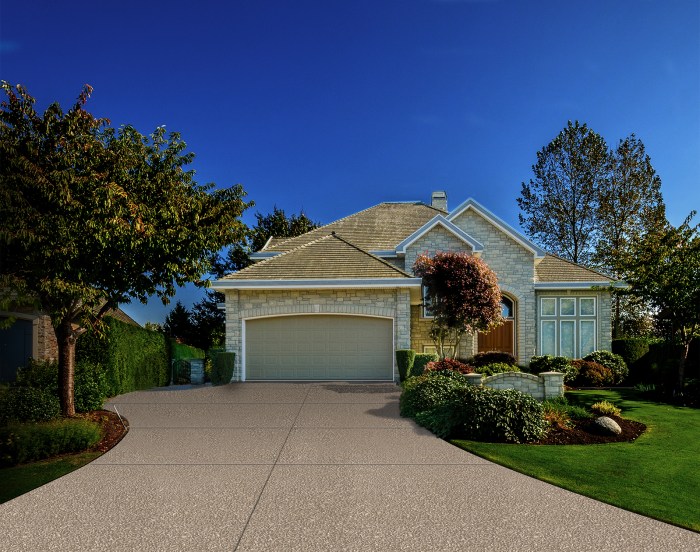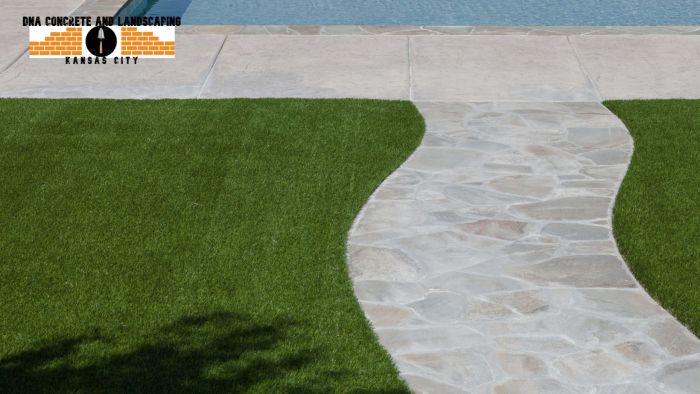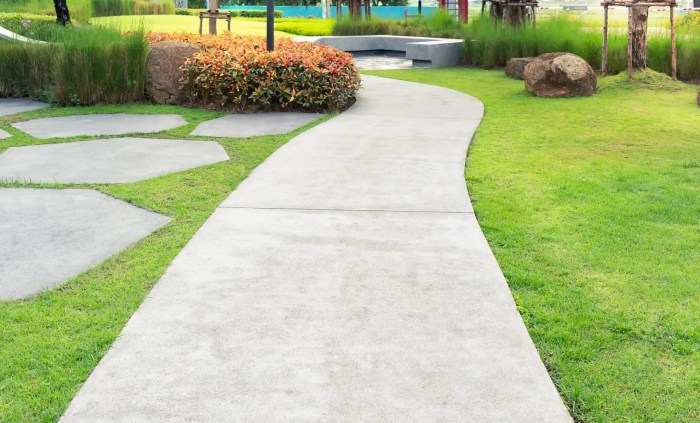Pathways and Driveways Design, Build, and Maintain
Pathways and driveways: they might seem simple, but these crucial elements of any property significantly impact both aesthetics and functionality. From the initial design considerations – choosing the right materials, ensuring proper drainage, and planning for accessibility – to the actual construction and ongoing maintenance, there’s a surprising amount of detail involved. This guide will walk you through every step, helping you create pathways and driveways that are both beautiful and durable.
We’ll explore various materials like concrete, asphalt, gravel, brick, and pavers, comparing their pros, cons, costs, and suitability for different climates and soil types. We’ll delve into design principles, focusing on accessibility, safety, and environmental impact. Learn how to plan your project effectively, from surveying your land to obtaining necessary permits. Finally, we’ll cover construction techniques and maintenance strategies to ensure your pathways and driveways stand the test of time.
Types of Pathways and Driveways

Source: co.uk
Choosing the right pathway or driveway material is a crucial decision impacting both the aesthetic and functional aspects of your property. Factors like budget, climate, and desired look all play a significant role in this selection process. This section will explore various materials, their pros and cons, and their suitability for different conditions.
Pathway and Driveway Material Comparison
The selection of materials for pathways and driveways is vast, each offering a unique blend of durability, aesthetics, and cost. Below is a table summarizing key characteristics of common materials. Remember that costs can vary significantly based on location, labor, and material quality.
| Material | Pros | Cons | Typical Cost (per square foot, approximate) |
|---|---|---|---|
| Concrete | Durable, versatile, relatively inexpensive | Can crack, requires regular sealing, can be monotonous visually | $4-$10 |
| Asphalt | Durable, relatively inexpensive, smooth surface | Can crack and deteriorate over time, requires regular maintenance, and can be susceptible to oil stains | $3-$8 |
| Gravel | Permeable, inexpensive, easy to install, natural look | Can shift and require maintenance, not suitable for high-traffic areas, can be messy | $1-$3 |
| Brick | Durable, attractive, wide variety of colors and styles | Expensive, requires professional installation, can be uneven | $8-$15 |
| Pavers (Stone, Concrete, etc.) | Durable, versatile, permeable options available, easy repair/replacement | Can be expensive, requires proper base preparation, and can be uneven if not installed properly | $6-$15 |
Aesthetic Appeal of Different Materials
The visual impact of pathways and driveways significantly contributes to the overall curb appeal of a property. Concrete, while durable, can appear somewhat plain unless creatively designed with stamped patterns or contrasting colors. Asphalt provides a smooth, dark surface, often associated with a more modern or utilitarian aesthetic. Gravel pathways offer a rustic, natural charm, particularly effective in landscapes with a natural or informal design. Brick pathways and driveways exude a classic, timeless elegance, with variations in color and pattern providing considerable design flexibility. For example, a red brick driveway can create a warm, inviting feel, while a grey brick driveway might convey a more sophisticated and contemporary atmosphere. Pavers, encompassing a wide range of materials and styles, offer the greatest design versatility, allowing for intricate patterns and a variety of colors and textures, from the smooth elegance of polished stone to the rugged texture of natural flagstone. The visual texture, ranging from the smooth surface of asphalt to the rough texture of gravel or the varied surfaces of brick and pavers, dramatically influences the overall aesthetic.
Material Suitability for Different Climates and Soil Conditions
Climate and soil conditions heavily influence the longevity and performance of pathway and driveway materials. In areas with harsh winters and frequent freeze-thaw cycles, concrete, and asphalt can be prone to cracking. Permeable materials like gravel and pavers are often better suited to these climates as they allow for water drainage, reducing the risk of frost heave. In hot, dry climates, materials that resist fading and cracking under intense sun exposure are preferable. Asphalt can soften in extreme heat, while lighter-colored materials like light-colored concrete or pavers can reflect sunlight and stay cooler. Soil conditions also play a critical role. Poorly draining soil necessitates the use of permeable materials or the installation of a robust drainage system to prevent water accumulation and potential damage. For areas with unstable soil, a solid base is crucial, regardless of the chosen surface material, to ensure long-term stability. For example, poorly drained clay soil might necessitate the use of gravel base and permeable pavers to prevent water damage and ensure stability.
Design and Planning Considerations: Pathways And Driveways

Source: behance.net
Designing pathways and driveways involves more than just choosing pretty stones; it’s about creating functional and aesthetically pleasing spaces that enhance your property’s value and usability. Careful planning ensures a smooth project, avoids costly mistakes, and ultimately results in a driveway and pathway system you’ll enjoy for years to come.
Proper grading and drainage are critical for the longevity and functionality of any pathway or driveway. Neglecting these aspects can lead to significant problems.
Pathway and Driveway System Design for a Hypothetical Property
Let’s imagine a suburban property with a slightly sloped front yard. The house sits back from the street, leaving ample space for a driveway and a walkway leading to the front door. The driveway, designed for two cars, would be made of asphalt, curving gently to accommodate the slope and providing ample turning space. The curve would be softened with landscaping – perhaps a border of low-growing shrubs and flowering plants. The walkway, constructed of interlocking pavers, would begin at the end of the driveway, meandering slightly to avoid a large oak tree. This walkway would incorporate a gentle ramp for accessibility, ensuring easy passage for individuals using wheelchairs or other mobility aids. To manage water runoff effectively, a slight crown would be incorporated into the driveway’s design, directing water towards the sides where drainage ditches, lined with gravel, would channel water away from the house and towards a storm drain. The walkway’s pavers would be laid with a slight slope to prevent water pooling.
Grading and Drainage Importance in Pathway and Driveway Construction
Imagine a driveway built on a flat surface with no consideration for drainage. After heavy rainfall, water would pool on the surface, potentially leading to erosion, damage to the pavement, and even structural problems for the house if the water accumulates near the foundation. Proper grading involves shaping the land to create a gentle slope, ensuring that water flows away from structures and paved areas. Effective drainage systems, such as ditches, culverts, or French drains, are essential to channel water safely away from the pathways and driveway, preventing water damage and maintaining the structural integrity of the surfaces. The combination of proper grading and a well-designed drainage system prevents the accumulation of standing water, reducing the risk of erosion, ice formation in winter, and damage to the pavement.
Step-by-Step Guide for Planning a Pathway and Driveway Project
Planning a pathway and driveway project requires a methodical approach. Careful consideration of each step will ensure a successful outcome.
- Surveying the Property: Begin by carefully surveying the property to determine the existing topography, identifying any underground utilities, and assessing the location and orientation of the house and other structures. This includes noting existing trees, plants, and other features that might influence the design.
- Obtaining Necessary Permits: Check with your local authorities to determine what permits are required for the construction of a driveway and pathway. This often involves submitting detailed plans and potentially undergoing inspections during the construction process.
- Material Selection: Choose materials that are durable, aesthetically pleasing, and suitable for the local climate. Consider factors such as cost, maintenance requirements, and the overall style of your home and landscape. Options include asphalt, concrete, pavers, gravel, or natural stone.
- Design Development: Develop detailed design plans, including grading plans and drainage solutions. These plans should indicate the dimensions, materials, and location of the driveway and pathways. This often involves consulting with professionals to ensure the design meets all relevant regulations and building codes.
- Budgeting and Contractor Selection: Create a realistic budget that includes the cost of materials, labor, permits, and any unexpected expenses. Select a reputable contractor who has experience in pathway and driveway construction, ensuring they have the necessary licenses and insurance.
- Construction and Inspection: Oversee the construction process, ensuring that it adheres to the approved plans and meets all relevant standards. Regular inspections throughout the construction phase help to catch any potential problems early on.
Construction and Maintenance

Source: behance.net
Building pathways and driveways involves careful planning and execution. The longevity and aesthetic appeal of your project depends heavily on the quality of the construction and the ongoing maintenance you provide. Choosing the right materials and techniques is crucial for a successful outcome. Proper maintenance will significantly extend the lifespan of your investment.
Pathway and Driveway Installation Techniques
Selecting the right installation method is crucial for the longevity and appearance of your pathways and driveways. The process varies depending on the chosen material. Following these steps will ensure a professional finish.
- Concrete Pathways and Driveways:
- Prepare the ground: Excavate to the desired depth, compact the base thoroughly and add a layer of gravel for drainage.
- Formwork: Construct forms to define the pathway’s shape and dimensions.
- Pour and level the concrete: Ensure a smooth, even surface, avoiding air pockets.
- Cure the concrete: Keep the concrete moist for several days to prevent cracking.
- Finish and seal: Apply a sealant to protect the concrete from weathering and staining.
- Brick Pathways and Driveways:
- Prepare the base: Create a level, compacted base of gravel or sand.
- Lay the bricks: Use a level to ensure a consistent surface. Leave appropriate spacing for jointing mortar.
- Apply mortar: Fill the joints between bricks with mortar to stabilize the structure.
- Compact and cure: Compact the bricks gently and allow the mortar to cure.
- Seal (optional): A sealant can help protect the bricks from staining and weathering.
- Gravel Pathways and Driveways:
- Prepare the ground: Excavate to the desired depth and shape.
- Install edging: Use landscape edging to contain the gravel.
- Add a geotextile fabric (optional): This prevents weed growth.
- Spread the gravel: Ensure an even distribution and desired depth.
- Compact (optional): Compact the gravel for a firmer surface.
Maintenance Requirements of Different Materials
Regular maintenance is essential for preserving the appearance and extending the lifespan of your pathways and driveways. Different materials have different maintenance needs.
| Material | Cleaning Method | Frequency |
|---|---|---|
| Concrete | Power washing, sweeping | Twice yearly |
| Brick | Sweeping, occasional pressure washing | Annually |
| Gravel | Raking, occasional top-up | As needed |
| Asphalt | Sweeping, crack filling (as needed) | Annually, crack repair as needed |
Extending the Lifespan of Pathways and Driveways
Proactive maintenance and timely repairs significantly contribute to the longevity of your pathways and driveways.
- Preventative Measures: Regular cleaning removes debris and prevents staining. Addressing minor cracks promptly prevents them from worsening. For concrete, applying a sealant every few years protects against water damage. For gravel, periodic top-ups replenish lost material.
- Repair Techniques: Small cracks in concrete can be repaired using patching compounds. Damaged bricks should be replaced. Loose gravel should be replenished. For asphalt, larger cracks may require professional repair.
Environmental Impact and Sustainability
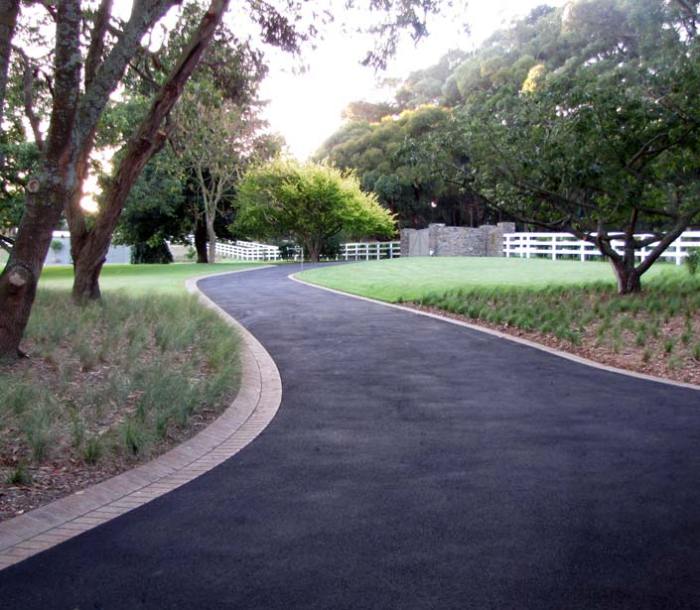
Source: com.au
Creating pathways and driveways has a significant environmental footprint, impacting everything from resource depletion to water runoff. Choosing sustainable materials and construction methods is crucial for minimizing this impact and promoting environmentally responsible landscaping. Let’s explore the environmental considerations involved in driveway and pathway construction and highlight some eco-friendly alternatives.
Environmental Impacts of Pathway and Driveway Materials
The environmental impact of pathway and driveway materials extends across their entire lifecycle – from raw material extraction and manufacturing to their eventual disposal. Asphalt, for example, requires significant energy for production and often contains petroleum-based components. Concrete production is energy-intensive and contributes to greenhouse gas emissions. The extraction of natural stone also has environmental consequences, including habitat disruption and potential soil erosion. At the end of their lifespan, these materials often end up in landfills, further contributing to environmental problems. Even seemingly benign materials like gravel can have indirect environmental impacts through transportation and potential dust pollution.
Sustainable Alternatives for Pathway and Driveway Construction
Fortunately, many sustainable alternatives exist for pathway and driveway construction. These options minimize environmental harm and often offer additional benefits.
Permeable Paving Materials and Stormwater Management
Permeable paving materials, such as porous concrete, gravel, and paving stones installed with gaps, play a vital role in managing stormwater runoff. These materials allow rainwater to seep through the surface, replenishing groundwater supplies and reducing the burden on storm drains. This helps mitigate flooding, erosion, and water pollution associated with traditional impervious surfaces. For example, a permeable paver driveway allows rainwater to infiltrate the ground beneath, reducing surface runoff and the potential for pollutants to enter waterways. This infiltration also helps to recharge groundwater aquifers, which are crucial sources of drinking water. The reduced runoff also minimizes the need for extensive and energy-intensive stormwater management infrastructure. A well-designed permeable pavement system can significantly reduce the volume of stormwater entering the drainage system, lessening the strain on the city’s infrastructure and reducing the risk of flooding.
Accessibility and Safety

Source: co.uk
Creating safe and accessible pathways and driveways benefits everyone, but especially those with disabilities. Careful design and maintenance are crucial for ensuring comfortable and hazard-free movement for all users. This section will detail design considerations for accessibility, common safety hazards, and effective lighting solutions.
Designing pathways and driveways with accessibility in mind ensures that people with disabilities can navigate them safely and independently. This improves quality of life and promotes inclusivity. Failing to consider accessibility can create significant barriers and limit access for many individuals.
Accessible Pathway and Driveway Design Features
Several key design features promote accessibility. These features cater to diverse needs and abilities, ensuring a safe and comfortable passage for everyone.
- Gentle Slopes: Avoid steep inclines. Aim for a maximum slope of 1:12 (8.33%) for wheelchairs and other mobility devices. Steeper slopes require ramps with appropriate landings.
- Wide Pathways: Provide ample width (at least 5 feet) to accommodate wheelchairs, walkers, and people using other assistive devices, and allow for comfortable passing.
- Smooth Surfaces: Choose materials with smooth, even surfaces to minimize tripping hazards. Avoid loose gravel, uneven paving stones, or cracked concrete.
- Clear Obstructions: Ensure pathways and driveways are free from obstructions like tree roots, low-hanging branches, or protruding objects. Properly placed and maintained landscaping is crucial.
- Tactile Paving: Install tactile paving at intersections and changes in direction to guide visually impaired individuals.
- Accessible Curb Ramps: Install ramps that comply with ADA guidelines at all curb cuts to provide smooth transitions between sidewalks and roadways.
- Adequate Lighting: Ensure sufficient lighting to improve visibility and safety, especially at night. This is crucial for all users, but particularly for those with visual impairments.
Safety Hazards and Preventive Measures
Poorly designed or maintained pathways and driveways pose several safety risks. Addressing these hazards proactively is essential to prevent accidents and injuries.
- Tripping Hazards: Uneven surfaces, protruding objects, cracks in pavement, and poorly maintained landscaping create tripping hazards. Regular inspections and prompt repairs are crucial.
- Slippery Surfaces: Ice, snow, and rain can make pathways and driveways slippery. Regular cleaning and the use of de-icing agents (when appropriate) are important safety measures.
- Poor Lighting: Insufficient lighting increases the risk of accidents, especially at night. Adequate lighting, as discussed below, is essential.
- Obstructions: Unsecured or poorly placed objects can create hazards. Ensure proper storage and secure any potential obstructions.
- Poor Drainage: Poor drainage can lead to water accumulation, creating slippery surfaces and potential flooding hazards. Proper grading and drainage systems are necessary.
Pathway and Driveway Lighting Options
Effective lighting significantly improves safety, especially at night. Different lighting options offer varying levels of illumination and energy efficiency.
- Incandescent Lighting: Traditional incandescent bulbs provide warm light but are energy-inefficient and have a short lifespan. They are becoming less common due to their high energy consumption.
- Halogen Lighting: Halogen bulbs offer brighter light than incandescent bulbs but are still relatively energy-inefficient. They generate more heat than other options.
- Fluorescent Lighting: Fluorescent lights are more energy-efficient than incandescent and halogen bulbs and offer longer lifespans. However, they can be more expensive upfront.
- LED Lighting: Light-emitting diodes (LEDs) are the most energy-efficient option, offering long lifespans and low heat output. They are becoming increasingly popular for outdoor lighting due to their efficiency and durability. LEDs also allow for various color temperatures and brightness levels, offering design flexibility.
- Solar Lighting: Solar-powered lights offer a sustainable and environmentally friendly option. They require minimal maintenance and are suitable for areas with sufficient sunlight.
End of Discussion
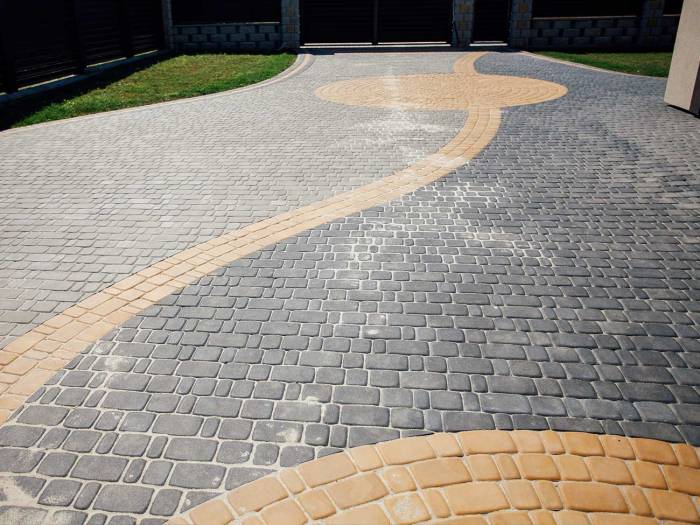
Source: co.uk
Creating stunning and functional pathways and driveways is a rewarding project that enhances the overall appeal and usability of your property. By carefully considering design, material selection, construction techniques, and ongoing maintenance, you can ensure a long-lasting and aesthetically pleasing result. Remember, proper planning and attention to detail are key to achieving a successful outcome. So, whether you’re embarking on a small residential project or a larger-scale undertaking, this guide provides the knowledge you need to navigate the process confidently.
